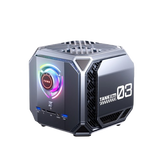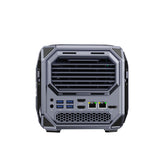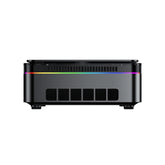HDMI 2.1 VS DisplayPort 1.4
When setting up a home theater, smart TV, gaming console, or PC, you'll need a cable to connect your device to a display. The question is, what choices do you have? If you're using high-definition devices, your primary choices are HDMI and DisplayPort. Even with these two options, there are many different versions, but the most current ones are DisplayPort 1.4 and HDMI 2.1. Which one is best for your setup? It will depend on a few factors, so let's break down this comparison.

What is HDMI 2.1?
HDMI 2.1 is the latest HDMI interface standard, offering significant improvements over previous versions in terms of bandwidth, resolution, refresh rate, and more. The main features of HDMI 2.1 include:
- Higher bandwidth: Supports higher resolutions and refresh rates, such as 8K@60Hz and 4K@120Hz.
- Lower latency: Suitable for latency-sensitive applications like gaming and VR.
- Dynamic HDR: Delivers more vivid and lifelike picture quality.
VRR (Variable Refresh Rate): Reduces screen tearing for a smoother experience.
What is DisplayPort 1.4?
DisplayPort 1.4 is also a common video interface standard, which supports high resolutions and high refresh rates. The features of DisplayPort 1.4 include:
- High resolution: Supports 8K@60Hz and 4K@120Hz high resolutions.
- High refresh rate: Suitable for fast-paced gaming.
- HDR: Supports HDR to enhance image quality.
- DSC (Display Stream Compression): Increases bandwidth efficiency without sacrificing image quality.
HDMI 2.1 and DisplayPort 1.4 are two common video interface standards that connect devices such as computers and gaming consoles to monitors. Their primary function is to transmit video and audio signals, but each has different performance characteristics.
| Features | HDMI 2.1 | DisplayPort 1.4 |
| Bandwidth | Higher: Supports higher resolutions and refresh rates | Relatively lower |
| Resolution | Supports high resolutions such as 8K@60Hz and 4K@120Hz | Supports high resolutions such as 8K@60Hz and 4K@120Hz |
| Refresh Rate | Supports higher refresh rates, ideal for fast-paced gaming | Supports high refresh rates |
| HDR | Supports Dynamic HDR for more vivid and lifelike visuals | Supports HDR |
| Audio | Supports eARC for improved audio quality | Supports high-quality audio |
| Other Features | VRR (Variable Refresh Rate) and ALLM (Auto Low Latency Mode) | DSC (Display Stream Compression) |
About HDMI 1.4 vs 2.0Recommended reading: HDMI 1.4 vs 2.0: What's the Difference and Which One Should You Choose?
Why choose HDMI 2.1 over DP 1.4 when using a PC?
When using a PC, choosing between HDMI 2.1 and DP 1.4 mainly depends on the following factors:
- Graphics Card Support: First, check if your graphics card supports HDMI 2.1 or DP 1.4.
- Monitor Support: Your monitor also needs to support the corresponding interface.
-
Usage Scenarios:
- Gamers: If you are a gamer looking for higher frame rates and lower latency, HDMI 2.1 is a good choice. Its support for VRR (Variable Refresh Rate) can effectively reduce screen tearing, providing a smoother gaming experience.
- Video Editing: If you are a video editor who requires high color accuracy, DP 1.4's DSC (Display Stream Compression) technology can offer better image quality.
Multi-screen Output: If you need to connect multiple monitors simultaneously, DP 1.4 may have an advantage as it supports daisy-chaining.
Which one should you use?
This covers the technical data, but which cable should you choose when purchasing?
Based on the original specifications, HDMI 2.1 seems to be the winner, but the situation is not always that clear-cut. In reality, the best cable depends on the application. Let's look at three common scenarios to help clarify when each video technology truly shines.
Highest Video Quality
If you are aiming for the highest resolution at the fastest frame rate, HDMI 2.1 comes out on top. This is evident from the data sheets. DisplayPort 1.4 simply cannot match the maximum output of HDMI 2.1.
Home Entertainment
If you're into home entertainment, where you might have a TV, Blu-ray player, and gaming consoles, the raw performance of HDMI 2.1 is no longer the primary concern. Instead, HDMI 2.1's versatility will shine.
HDMI 2.1 is backward compatible with other HDMI formats. This means you can use one set of cables to connect the latest gaming consoles, older consoles (which cannot take advantage of the 2.1 performance specs), TVs, streaming devices, and anything else. It's easier to use HDMI to connect everything, and you can ensure that you have 2.1 performance where and when it matters most.
Multi-Monitor PC
So far, HDMI 2.1 has been dominant, but we now enter a category where DisplayPort 1.4 still shines. When using a PC, HDMI 2.1 still provides the best video quality, but graphics cards often favor DisplayPort.
With a modern PC, you might have one HDMI 2.1 port, which you can use to achieve great resolution and frame rates. However, if you want to connect multiple monitors, the remaining ports are likely DisplayPort 1.4. Therefore, DisplayPort is ready and set for multi-monitor functionality, making it easier to take advantage of this fact.

How should gamers choose?
For gamers, choosing between DisplayPort 1.4 and HDMI 2.1 mainly depends on the following factors:
- Graphics Card Support: First, ensure that your graphics card supports DisplayPort 1.4 or HDMI 2.1.
- Monitor Support: Your monitor also needs to support the corresponding interface.
- Personal Needs:
- Pursuing Extreme Frame Rates: If you're an FPS gamer seeking the highest frame rates, HDMI 2.1 might be more suitable, as it can offer higher refresh rates in certain scenarios.
- Focusing on Image Quality: If you prioritize image quality, DisplayPort 1.4's DSC (Display Stream Compression) technology can provide better image quality.
- Multi-Screen Output: If you need to connect multiple monitors simultaneously, DisplayPort 1.4's daisy-chaining feature will be more convenient.
Comparison of DisplayPort 1.4 and HDMI 2.1
| Features | DisplayPort 1.4 | HDMI 2.1 |
| Bandwidth | Higher | Relatively Lower |
| Resolution | Supports 8K@60Hz, 4K@144Hz | Supports 8K@60Hz, 4K@120Hz |
| Refresh Rate | Higher | Relatively Lower |
| HDR | Supported | Supported |
| DSC | Supported | Not Supported |
| VRR | Supported | Supported |
| eARC | Not Supported | Supported |
| Multi-Screen Output | Supports Daisy Chaining | Does Not Support Daisy Chaining |
Conclusion
Both DisplayPort 1.4 and HDMI 2.1 can provide an excellent visual experience for gamers. The choice primarily depends on your personal needs and device compatibility.
In general:
- If you're an FPS gamer pursuing extreme frame rates and both your graphics card and monitor support HDMI 2.1, then HDMI 2.1 is a suitable choice.
- If you prioritize image quality or need to connect multiple monitors simultaneously, then DisplayPort 1.4 is the better option.
Tip: Before purchasing a monitor or graphics card, it's best to check the types of interfaces they support to avoid any unnecessary issues
FAQ
Q1: Which is better, HDMI 2.1 or DisplayPort 1.4?
Answer: There is no definitive answer to this question; both have their advantages and disadvantages, depending on your specific needs.
- HDMI 2.1: Widely adopted with broad compatibility, suitable for connecting various devices like gaming consoles, TVs, and audio systems. It performs well at 4K 120Hz, making it ideal for gamers.
- DisplayPort 1.4: Offers higher performance and bandwidth, supporting higher resolutions and refresh rates. It's suitable for professional monitors and high-end gamers, with an advantage at 8K resolution.
Q2: What are the main differences between HDMI 2.1 and DisplayPort 1.4?
Answer:
- Bandwidth: HDMI 2.1 has a bandwidth of 48Gbps, while DisplayPort 1.4 has a bandwidth of 32.4Gbps.
- Resolution and Refresh Rate: HDMI 2.1 supports 4K at 120Hz, while DisplayPort 1.4 supports 8K at 60Hz.
- Features: Both support HDR and VRR (Variable Refresh Rate), but DisplayPort 1.4 has an advantage in multi-monitor output.
- Interface: HDMI ports are more commonly found, whereas DisplayPort is primarily used for computer monitors.
Q3: Which is better for gaming, HDMI 2.1 or DisplayPort 1.4?
Answer: It depends on the support provided by your monitor and graphics card.
- General Gaming: HDMI 2.1 is sufficient for most gaming needs. Its 4K at 120Hz capability provides a very smooth experience, making it an optimal choice for many modern gaming consoles.
- High-End Gaming or Those Who Demand the Best Image Quality: DisplayPort 1.4 is commonly used for PC gaming. Its higher bandwidth and refresh rate can offer a better gaming experience, especially at 8K resolution. For PC gamers, DisplayPort is more common, particularly for multi-monitor setups.
Q4: What is the difference between HDMI 2.1 and DisplayPort 1.4 cables?
Answer:
- HDMI 2.1 Cables: Require support for 48Gbps high-speed transmission, making them relatively more expensive.
- DisplayPort 1.4 Cables: Also need to support high-speed transmission but are generally less expensive.
- Recommendation: It's advisable to choose certified cables to ensure transmission quality.
Q5: How to choose between HDMI 2.1 and DisplayPort 1.4?
Answer:
- Consider Device Compatibility: First, confirm whether your devices support HDMI 2.1 or DisplayPort 1.4.
- Consider Resolution and Refresh Rate Requirements: Choose the appropriate resolution and refresh rate based on your needs.
Consider Budget: HDMI 2.1 devices and cables are generally more affordable, while DisplayPort 1.4 tends to be more expensive.







Leave a comment
Please note, comments need to be approved before they are published.